英语选修7外研版Module 5 Section Ⅰ Introduction & Reading —Pre reading课件
文档属性
| 名称 | 英语选修7外研版Module 5 Section Ⅰ Introduction & Reading —Pre reading课件 |  | |
| 格式 | zip | ||
| 文件大小 | 1.4MB | ||
| 资源类型 | 教案 | ||
| 版本资源 | 外研版 | ||
| 科目 | 英语 | ||
| 更新时间 | 2013-01-20 11:58:23 | ||
图片预览

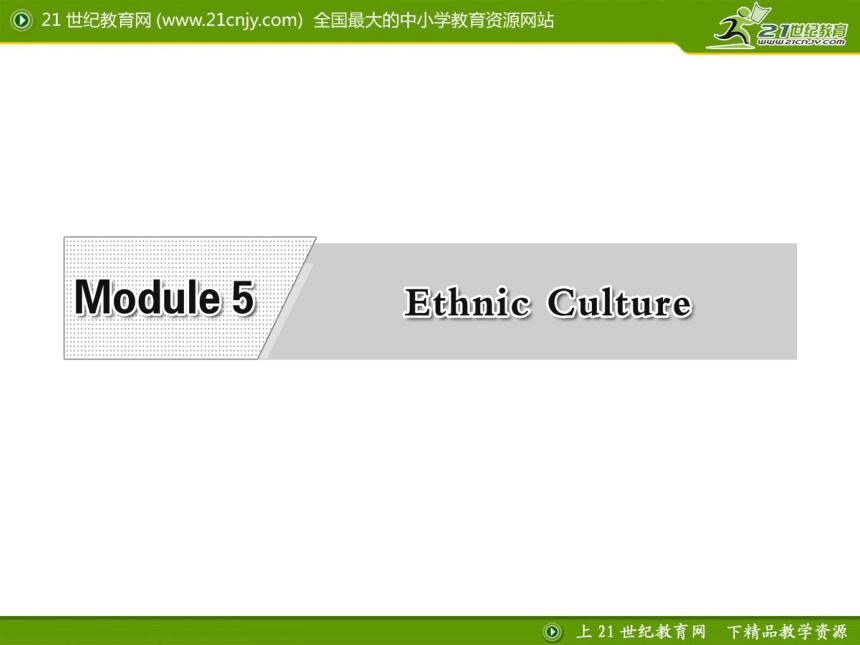
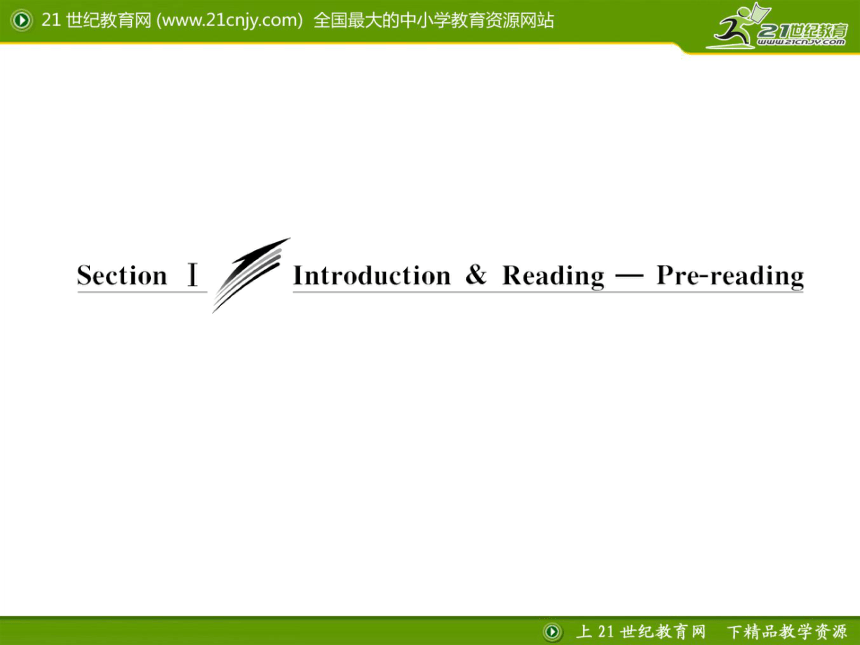
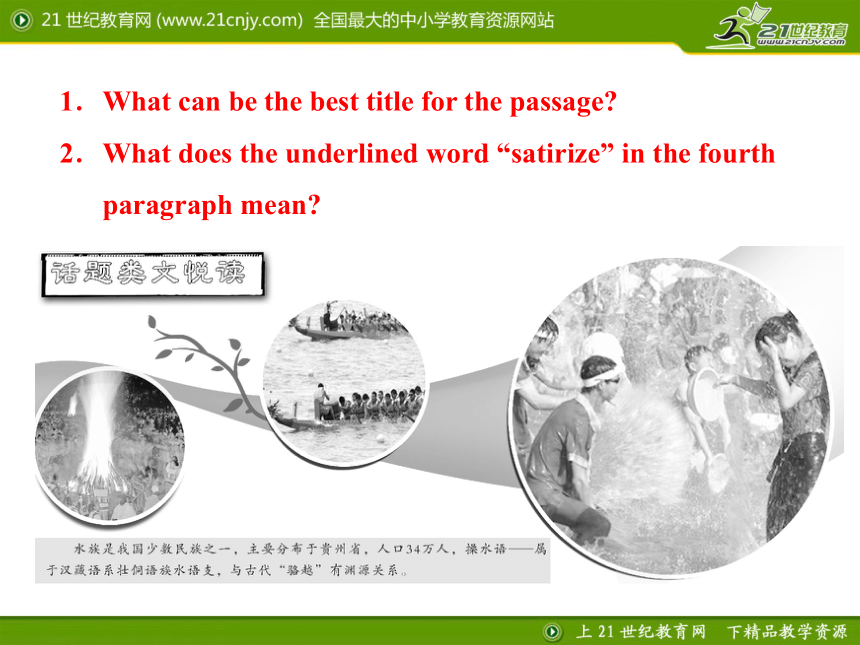
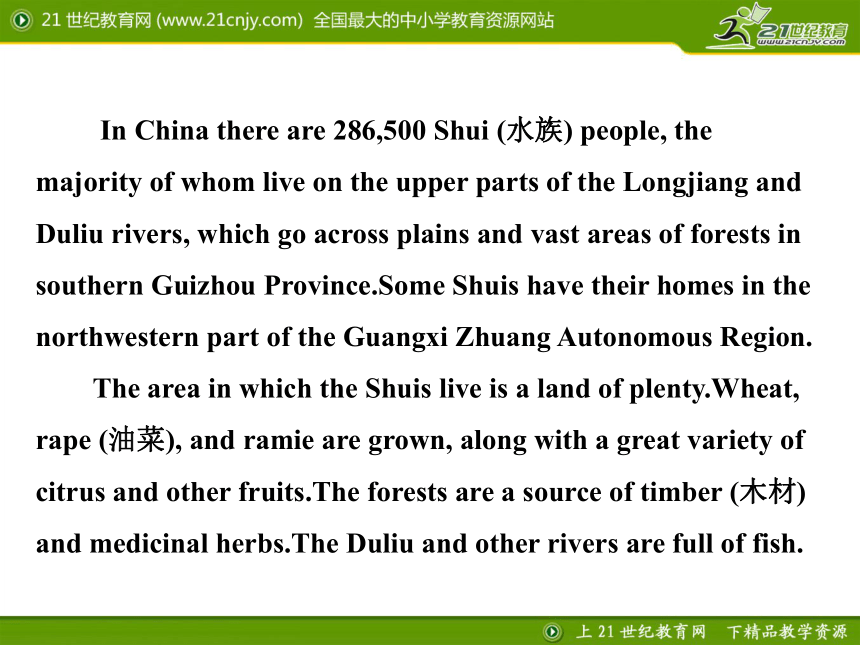
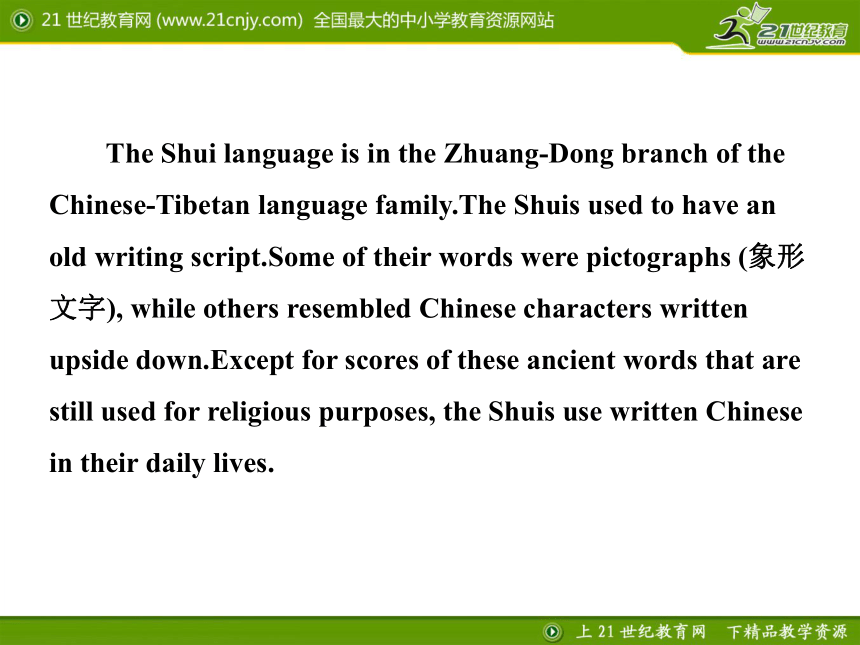
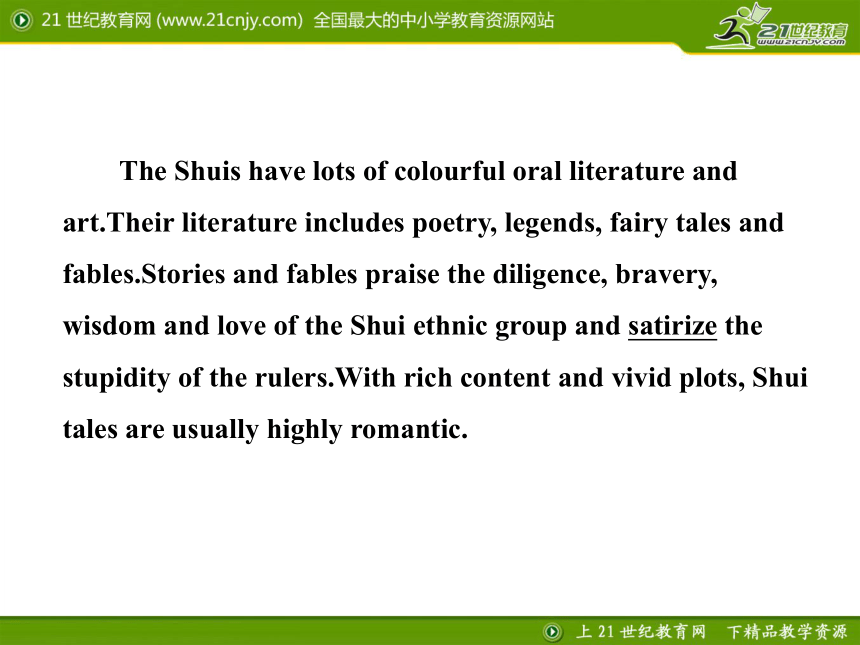
文档简介
课件18张PPT。Module 5 Ethnic Culture SectionⅠ Introduction & Reading — Pre-readingStep 1Step 2Step 3Step 4Step 51.What can be the best title for the passage?
2.What does the underlined word “satirize” in the fourth
paragraph mean? In China there are 286,500 Shui (水族) people, the majority of whom live on the upper parts of the Longjiang and Duliu rivers, which go across plains and vast areas of forests in southern Guizhou Province.Some Shuis have their homes in the northwestern part of the Guangxi Zhuang Autonomous Region.
The area in which the Shuis live is a land of plenty.Wheat, rape (油菜), and ramie are grown, along with a great variety of citrus and other fruits.The forests are a source of timber (木材) and medicinal herbs.The Duliu and other rivers are full of fish. The Shui language is in the Zhuang-Dong branch of the Chinese-Tibetan language family.The Shuis used to have an old writing script.Some of their words were pictographs (象形文字), while others resembled Chinese characters written upside down.Except for scores of these ancient words that are still used for religious purposes, the Shuis use written Chinese in their daily lives. The Shuis have lots of colourful oral literature and art.Their literature includes poetry, legends, fairy tales and fables.Stories and fables praise the diligence, bravery, wisdom and love of the Shui ethnic group and satirize the stupidity of the rulers.With rich content and vivid plots, Shui tales are usually highly romantic. Their songs, which are usually sung without the accompaniment (伴奏) of musical instruments, fall into two categories.The “grand songs” are sung while they work, whereas the “wine songs” are meant for wedding feasts or funerals.The Shui people are good dancers.The Lusheng Dance and the Copper Drum Dance are the most popular dances, enjoyed by all on festive occasions.1.There are 55 minorities in China. Please name as many
as you can.
______________________________________________________________________________________________
参考答案:The Zhuang, The Man, The Hui, The Miao, The Mongol, The Zang, etc.2.Can you match each of the following pictures with a
certain festival?
A.The Dragon Boat Festival
B.The Mid-Autumn Festival
C.The Bai Torch Festival
D.The Dai Water-Splashing Festival答案:(1)D (2)C (3)A (4)BMatch the main idea with each paragraph.
1.Para.1 A.The Naxi music
2.Para.2 B.The Naxi ethnic group
3.Para.3 C.The landscape
4.Para.4 D.The Naxi language
5.Para.5 E.The old town
6.Para.6 F.Leaving Lijiang for Kunming
答案:1.C 2.E 3.B 4.D 5.A 6.FⅠ.Ture (T) or False (F).
1.The landscape of Yunnan is quite varied. ( )
2.Tourists can go sight-seeing in the old town of Lijiang in
their cars. ( )
3.Naxi society is still run by women now. ( )
4.The Naxi language has a history of over 1,000 years. ( )
5.Naxi culture is particularly famous for its painters and
writers. ( )TFTTFⅡ.Choose the best answer according to the passage.
1.Why did Simon Wakefield go to Yunnan?
A.Because he studied in Yunnan University.
B.Because he wanted to study Naxi culture.
C.Because he wanted to travel round Yunnan.
D.We don't know.2.From the passage we can know that ________.
A.Lijiang has many mazes
B.the Naxi ethnic group like to play cards in the street
C.four rivers run around the city
D.only the Naxi ethnic group live in Lijiang
3.Which of the following is TRUE according to the passage?
A.The writer thinks his stay in Lijiang is worth remembering.
B.Naxi music has not changed for about eight centuries.
C.Naxi culture is particularly famous for its architecture.
D.The Naxi only wear traditional costume at festivals.4.Which of the words can be used to describe the lifestyle in
the old town Lijiang?
A.Stressful. B.Leisurely.
C.Tough. D.Boring.
5.The passage is mainly about ________.
A.the varied landscape in Yunnan
B.the unusual Naxi women
C.the only hieroglyphic language in use
D.what the writer saw and what he learned about in
Yunnan, or rather Lijiang
答案: 1. C 2.B 3.A 4.B 5.DFill in the blanks according to the passage.
I'm astonished by how 1. the landscape is. Down in the south, it's very 2. , but in the north, Lijiang, a half new and half old town is on the side of a mountain and
3. it is Yulong Xueshan Mountain, its peak 4.
with snow. Seen from above, the old town is a maze that tourists get lost in.This region is where the Naxi 5. groupvariedtropicalcoveredethnicoppositelive. It's the women who 6. Naxi society. They inherited all 7. and have the custom of playing cards in the middle of the street. The Naxi language is the only hieroglyphic language still 8. . Naxi culture is particularly famous for its music. 9. from father to son, the music hasn't changed for centuries. At last I know 10. different we may appear to be at first, we are all the same, all equal.runpropertyin usePassedhowever1.Do you think it is important that ethnic minority cultures
should continue?
____________________________________________________
参考答案:①Of course, I think it's very important.
②They should continue the way they've lived for hundreds
of years.
2.Is it necessary for people to have their own culture?
____________________________________________________
参考答案:Yes. People should be allowed to have their own culture. Only in this way can we have a multi-cultural society.
2.What does the underlined word “satirize” in the fourth
paragraph mean? In China there are 286,500 Shui (水族) people, the majority of whom live on the upper parts of the Longjiang and Duliu rivers, which go across plains and vast areas of forests in southern Guizhou Province.Some Shuis have their homes in the northwestern part of the Guangxi Zhuang Autonomous Region.
The area in which the Shuis live is a land of plenty.Wheat, rape (油菜), and ramie are grown, along with a great variety of citrus and other fruits.The forests are a source of timber (木材) and medicinal herbs.The Duliu and other rivers are full of fish. The Shui language is in the Zhuang-Dong branch of the Chinese-Tibetan language family.The Shuis used to have an old writing script.Some of their words were pictographs (象形文字), while others resembled Chinese characters written upside down.Except for scores of these ancient words that are still used for religious purposes, the Shuis use written Chinese in their daily lives. The Shuis have lots of colourful oral literature and art.Their literature includes poetry, legends, fairy tales and fables.Stories and fables praise the diligence, bravery, wisdom and love of the Shui ethnic group and satirize the stupidity of the rulers.With rich content and vivid plots, Shui tales are usually highly romantic. Their songs, which are usually sung without the accompaniment (伴奏) of musical instruments, fall into two categories.The “grand songs” are sung while they work, whereas the “wine songs” are meant for wedding feasts or funerals.The Shui people are good dancers.The Lusheng Dance and the Copper Drum Dance are the most popular dances, enjoyed by all on festive occasions.1.There are 55 minorities in China. Please name as many
as you can.
______________________________________________________________________________________________
参考答案:The Zhuang, The Man, The Hui, The Miao, The Mongol, The Zang, etc.2.Can you match each of the following pictures with a
certain festival?
A.The Dragon Boat Festival
B.The Mid-Autumn Festival
C.The Bai Torch Festival
D.The Dai Water-Splashing Festival答案:(1)D (2)C (3)A (4)BMatch the main idea with each paragraph.
1.Para.1 A.The Naxi music
2.Para.2 B.The Naxi ethnic group
3.Para.3 C.The landscape
4.Para.4 D.The Naxi language
5.Para.5 E.The old town
6.Para.6 F.Leaving Lijiang for Kunming
答案:1.C 2.E 3.B 4.D 5.A 6.FⅠ.Ture (T) or False (F).
1.The landscape of Yunnan is quite varied. ( )
2.Tourists can go sight-seeing in the old town of Lijiang in
their cars. ( )
3.Naxi society is still run by women now. ( )
4.The Naxi language has a history of over 1,000 years. ( )
5.Naxi culture is particularly famous for its painters and
writers. ( )TFTTFⅡ.Choose the best answer according to the passage.
1.Why did Simon Wakefield go to Yunnan?
A.Because he studied in Yunnan University.
B.Because he wanted to study Naxi culture.
C.Because he wanted to travel round Yunnan.
D.We don't know.2.From the passage we can know that ________.
A.Lijiang has many mazes
B.the Naxi ethnic group like to play cards in the street
C.four rivers run around the city
D.only the Naxi ethnic group live in Lijiang
3.Which of the following is TRUE according to the passage?
A.The writer thinks his stay in Lijiang is worth remembering.
B.Naxi music has not changed for about eight centuries.
C.Naxi culture is particularly famous for its architecture.
D.The Naxi only wear traditional costume at festivals.4.Which of the words can be used to describe the lifestyle in
the old town Lijiang?
A.Stressful. B.Leisurely.
C.Tough. D.Boring.
5.The passage is mainly about ________.
A.the varied landscape in Yunnan
B.the unusual Naxi women
C.the only hieroglyphic language in use
D.what the writer saw and what he learned about in
Yunnan, or rather Lijiang
答案: 1. C 2.B 3.A 4.B 5.DFill in the blanks according to the passage.
I'm astonished by how 1. the landscape is. Down in the south, it's very 2. , but in the north, Lijiang, a half new and half old town is on the side of a mountain and
3. it is Yulong Xueshan Mountain, its peak 4.
with snow. Seen from above, the old town is a maze that tourists get lost in.This region is where the Naxi 5. groupvariedtropicalcoveredethnicoppositelive. It's the women who 6. Naxi society. They inherited all 7. and have the custom of playing cards in the middle of the street. The Naxi language is the only hieroglyphic language still 8. . Naxi culture is particularly famous for its music. 9. from father to son, the music hasn't changed for centuries. At last I know 10. different we may appear to be at first, we are all the same, all equal.runpropertyin usePassedhowever1.Do you think it is important that ethnic minority cultures
should continue?
____________________________________________________
参考答案:①Of course, I think it's very important.
②They should continue the way they've lived for hundreds
of years.
2.Is it necessary for people to have their own culture?
____________________________________________________
参考答案:Yes. People should be allowed to have their own culture. Only in this way can we have a multi-cultural society.
